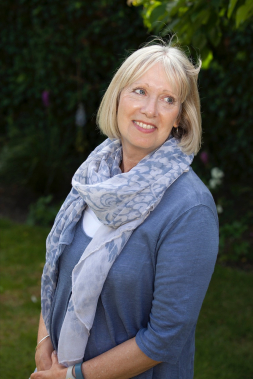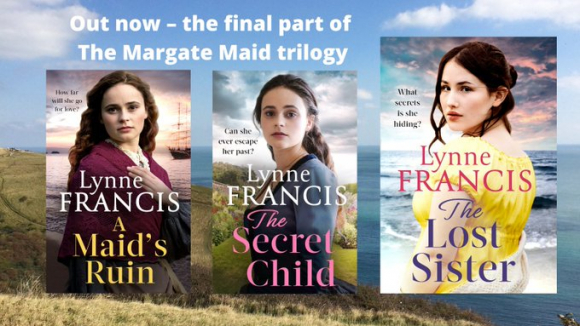Following on from my review of A Maid's Ruin by Lynne Francis in last week's blog, I'm delighted this week to welcome Lynne herself.
One feature of her book that I loved was the vivid descriptions of the various locations and Lynne has written a piece to introduce the various places that inspired the novel. |  |
A big thank you to Susanna, for inviting me to write a guest post for her blog.
h
I write historical sagas, set mainly in the late eighteenth and early nineteenth centuries and have completed two trilogies: one set in Yorkshire, the other in Kent. Place is key in all my novels – it’s usually a visit to a location that sparks an idea for a story, or an element of a story. Then a character or two pops into my head, and off I go!

The inspiration for the first book in The Margate Maid trilogy, A Maid’s Ruin, came when I visited particular streets in the seaside town of Margate, east Kent, to discover where my own family members had lived in the early 1800s. One of my ancestors had owned a cow barn and sold milk, and Molly, my main character and a dairymaid at the start of the book, was inspired by this discovery.
Amongst all the research I did to imagine what life might have been like back then, I looked at etchings and paintings. William Turner, the artist, had stayed and studied in that location at the same time, and painted St John’s Church, the big church local to my ancestors, when he was only around eleven years old. This led me to create the opening scene of the novel, in which I imagined Molly meeting the young Turner. Two other early paintings of the area by Turner inspired me to create scenes in the novel – one of two ladies outside a shop in the High Street, another of the rather wonderful Dent de Lion.

Margate harbour, seen today, is very different from the way it would have looked in Turner’s time – but the skies and the light are still exceptional. |  |
Gardens are key locations in all three books of the trilogy: in A Maid’s Ruin, Charlie is initially a gardener at the poor house, where he is visited by the young Molly on several occasions. I love walled gardens, which would have been predominantly kitchen gardens in the past. The one shown here is at Mt Ephraim, near Faversham – Charlie’s garden would have grown far more food than flowers.

There is a fascinating set of underground tunnels in the heart of Margate, their walls encrusted with over 4 million shells in ornate patterns. Known as the Shell Grotto, its history is shrouded in mystery. I paid the Grotto a visit and it, too, found its way into my story, playing a key part in the development of Molly’s infatuation with her cousin, Nicholas.
An unexpected development in the early stages of writing the story came on a trip to the Foundling Museum in Brunswick Square, London. The very moving information I found there about the Foundling Hospital, set up by Thomas Coram in the mid-1700s in Lamb’s Conduit fields, sparked an idea for a development in the story, which led Molly on a journey to London.

Poring over an old map of London from the era, and imagining Molly moving through the streets, I found the Apothecary’s Garden on the bank of the Thames in Chelsea. It’s now the Chelsea Physic Garden, somewhere I had visited some years previously. Out of that grew the idea for an important scene and location in the latter part of the novel, where Charlie comes across Molly in unexpected circumstances.
The end of the novel takes us back to Margate and to the Woodchurch Manor estate, which is loosely based on Quex House and the Powell-Cotton Museum in Birchington, east Kent.

The garden there which is such an important location in the next two books, is an amalgamation in my head of many of the beautiful gardens I have visited throughout the UK – this one is Goodnestone, which Jane Austen used to visit.
* * * *
Lynne Francis grew up in Yorkshire but studied, lived and worked in London for many years. She draws inspiration for her novels from a fascination with family history, landscapes and the countryside.
Her first saga series was set in west Yorkshire but a move to east Kent, and the discovery of previously unknown family links to the area, gave her the idea for a Georgian-era trilogy. Lynne’s exploration of her new surroundings provided the historical background for the novels, as well as allowing her to indulge another key interest: checking out the local teashops and judging the cake.
When she’s not at her desk, writing, Lynne can be found in the garden, walking through the countryside or beside the sea.
* * * *
Lynne's links:
Lynne's author page on Amazon
Lynne's Twitter page
Lynne's author page on Facebook
* * * *



Make A Comment
Comments (0)